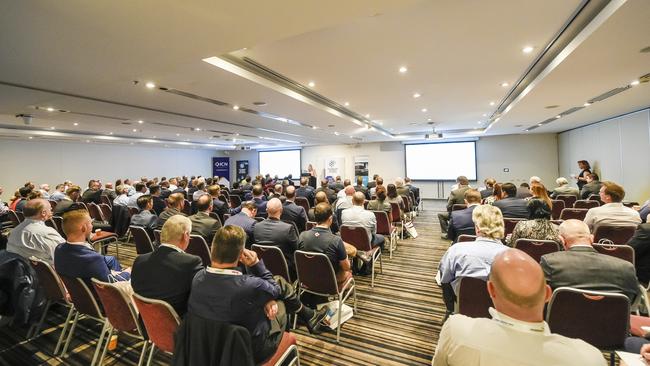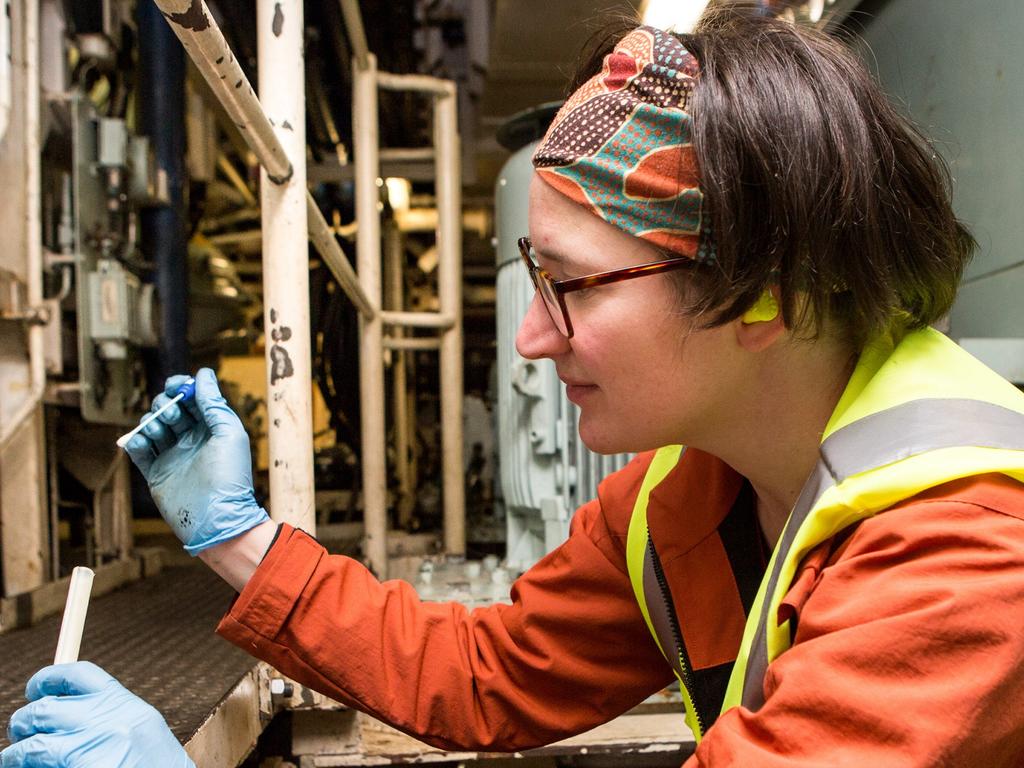Guide for manufacturers on how to navigate Australia’s vast defence market
Questions on breaking into the local defence-manufacturing industry, and answers from the Defence Teaming Centre.

Small-to-medium enterprises (SMEs) — generally independent businesses with fewer than 200 employees — are believed now to do about half the defence manufacturing in Australia, which employs about 30,000 people. Prime contractors do the other half. The SMEs are estimated to comprise about 3000 local businesses, and are a focus of this week’s PACIFIC 2019 Expo and conferences.
With the federal government committing about $200bn in new defence “capability’’, plus the opportunities arising from the more costly sustainment, there is a campaign to bring more local factories into the fold. The Defence Teaming Centre is one of the industry associations at the centre of manufacturing growth. The Defence Teaming Centre chief executive, Audra McCarthy, answers questions for potential entrants.
Is the future of SME defence-chain manufacturing for new entrants almost always a matter of setting up an alternative work stream rather than the main focus for new entrants?
The Defence Force needs a diversified network of industry supporting and supplying goods and services. SMEs need to be diversified across multiple sectors, which enables businesses to withstand the peaks and troughs of these markets. Established businesses from other sectors are often encouraged to consider the defence market as an option to grow their business as experience has shown that adjacent sectors, such as oil and gas, are supported by mature, innovative businesses that have much to offer Defence. This means defence should be one of a number of market sectors in which a business operates.

For most new entrants, is it better to establish relationships with existing tier-two suppliers rather than with prime contractors, or are both essential?
New entrants to the defence sector are strongly encouraged to do their homework. Know your organisation’s strategy, your products and services and clearly identify your target market. Doing your homework upfront will enable you to clearly identify your target customer. Know your buyer and research your end-user. Take the time to understand what the customer wants. Don’t think only about the technical solution, but consider the delivery model, supply chain and ongoing sustainment of the product/service you are supplying. Innovative companies developing leading-edge technology and products may be better suited to engaging the Department of Defence directly.
Organisations producing commodity parts or products may be better suited targeting a defence prime or tier-two supplier. Most importantly, take the time to research the market and define your strategy and target markets accordingly. Adopting a scattergun approach to promoting your organisation in the defence sector is not advisable. The business development life-cycle for the defence market is long. It is not uncommon for organisations to invest at least three to five years before they realise their first purchase order. While there are instances of organisations landing opportunities in defence very quickly, the majority of opportunities take a while to come to fruition. This is largely because the supply chain is dealing with complex products and services. We are talking about projects that involve leading-edge technology, that require integration with existing systems and capabilities. This requires complex engineering skills and analysis which takes time to undertake.
Furthermore, the procurement decision-making process requires various approvals, including ministerial approvals, which takes time. Organisations therefore need to ensure the time they invest in pursuing and developing opportunities in defence is going to contribute positively to a greater likelihood of success.
Is there a need for management upskilling within SMEs to take advantage of opportunities and how can this be obtained?
In addition to the technical skills required by the business to develop its suite of products and services, SMEs need to ensure their management team are experienced in project management, contract/subcontract management, risk management, quality management and commercial management. These are typically core management skills commonly available through the university sector and training providers.
The Defence Teaming Centre has partnered with delivery partners such as the University of Adelaide and Heavypoint to develop leadership programs that build on these foundational management skills and develop leaders specifically for the defence-industry sector. The DTC’s Defence Industry Program develops leadership skills to the Australian Qualifications Framework 5/6 level, while the University of Adelaide’s Professional Certification in Defence Industry Leadership Program provides credit towards an MBA.
The trend of procurement seems to be leaning more towards buying in packages of different components that go together. What does this mean for SMEs?
Primes are wanting the supply chain to perform integration and sub-assembly work where possible. Smart SMEs will see this as an opportunity as it enables the SME to grow its business by moving up the value chain. Adopting a value-chain approach to supplying to the sector will require SMEs to team and collaborate. Our industrial landscape is comprised of many very small businesses who individually lack the capacity to perform the work forecast by some of the major programs. If suitable suppliers can’t be found in Australia, the work will most likely be undertaken offshore.
SMEs will need to learn to work together to provide a supply-chain solution that meets the buyer’s need. This may involve direct competitors learning to work together to win work. If they don’t learn to work together, everyone loses. The DTC has already commenced work in this space, piloting a number of collaboration workshops that have been instrumental in positioning SMEs for major opportunities in the maritime sector. The DTC’s Teaming & Collaboration Program brings businesses together to agree on participation terms and develop a viable solution for the Australian market; a solution that better positions Australian industry for inclusion in defence work and reduces the risk of work being undertaken overseas.
Looking at the Naval Group two-year sourcing evaluation process as an example, are Australian SMEs generally able to cope with this long delay for possible contracts, and the extra "paperwork" involved?
The sourcing and evaluation periods in defence supply chains are long and the governance and associated paperwork required to enter the defence sector is high. The sector requires traceability as the parts and technology are complex and the capability to which goods and services are being fitted to protect the lives of the men and women serving Defence. Consequently newcomers to the sector often underestimate the overhead costs associated with doing business in defence.
The pricing of goods and services for defence requires a different approach to other markets and, because the procurement cycles are long, organisations require a healthy source of working capital to sustain the business during the long business-development and contract-negotiation process.
SMEs new to defence are encouraged to think carefully about their approach to pricing defence work and take the time to consider all of the associated overhead costs of doing business in defence, such as increased insurance, quality management, contract management, enhanced security management and travel. In most cases, SMEs will need to employ additional resources to handle the increased overhead.
How do SMEs best adapt to calculating and describing Australian industry content in tenders or submissions. Should they outsource for advice?
The majority of Australian SMEs won’t find it difficult to identify the value of Australian industry capability included in their submission. This is because the majority of work undertaken by SMEs is undertaken in-house, in-country using Australian staff. Where organisations subcontract work again, this is often subcontracted to another local supplier, so the value of Australian industry involved in the submission is very easy to calculate. In fact, for many Australian SMEs, this is a key discriminator. Being a wholly owned Australian business undertaking work in-house using local staff is exactly what the government is trying to achieve through the Australian Industry Capability policy. The Department of Defence has provided some very useful information on their website, including the AIC Better Practice Guide and the DTC intends to roll information out for members and broader industry next year.
How should SMEs stay informed on sustainment opportunities for the troughs between parts-making work?
Keeping abreast of sustainment opportunities can be tough as it requires ongoing research and market scanning. This requires time, a commodity that most SMEs don’t have. Opportunities may arise in the form of new projects as programs are released to the market through Austender. Alternatively, opportunities may arise where an existing supplier is not performing and the prime is looking for a new, more reliable supplier. These opportunities typically arise through word-of-mouth and through business introductions. Defence industry associations keep members abreast of opportunities as and when they arise through regular email updates. We do the research and communicate these opportunities to our members. Defence primes also utilise the DTC to identify capability for inclusion in bids and projects by asking us to identify companies possessing the capability they require who we know will meet their supply-chain standards.
Will SMEs interested in defence need to give more attention to verifiable recording of their contract performance?
Demonstrated contract performance is a key differentiator for an SME. It is one thing for a SME to say they have a track record in on-time delivery with 100 per cent quality, it’s another to go one step further and show how the company routinely measures and monitors these results for their major customers. Companies who measure and monitor their on-time delivery performance can objectively demonstrate their organisation’s commitment to customer service and, more importantly, continuous improvement. A well deployed continuous improvement system will support an SME in remaining competitive and innovative in a highly globally competitive market, which are traits highly valued and sought after by Defence.
How can SMEs contribute more to defence innovation, and how can they better access it?
SMEs by nature are generally very innovative. In fact, Australian SMEs are widely known internationally for their smarts and their ability to “think outside the box”. Australian SMEs naturally adopt a “can-do” attitude to product design and delivery, which is more prevalent in the defence sector. The challenge for the SME is finding the right person in Defence or a defence prime to promote the innovation to. Complex configuration management, convoluted engineering change request processes and the Defence posting cycle make it very difficult for SMEs to find the right person to talk to. Defence is beginning to take notice of this problem and programs like the Defence Innovation Hub and the Next Generation Technologies Fund have brought some relief. We are also seeing changing behaviours in Defence where the various groups are actively engaging industry to provide them with the opportunity to showcase their innovation. The Army Innovation Day is a great example of this, along with the air force’s Plan Jericho and the Chief of Navy’s Industry Engagement strategy. This is a good example of where defence-industry associations have an important role to play. Through connections in Defence, defence primes and the wider research and academic sector, associations are able to facilitate the right introductions to the right people to better promote and commercialise innovation.
How best to identify likely opportunities rather than become lost in the maze?
The defence sector can definitely be a maze and, while there is much activity forecast for the foreseeable future, particularly in the shipbuilding sector, SMEs should be warned of the challenges. As already highlighted, the procurement decision-making process is long and the products being delivered are often complex.
SMEs need to be very clear about who they are targeting and for what opportunities. Opportunities will require attendance at several meetings and potentially several overseas trips before a purchase order is written. Defence and defence primes are large organisations and it can be difficult identifying the right person to speak with. As a general guide, work smarter, not harder.
Leverage from the services available from the department’s Centre for Defence Industry Capability. Their team of defence-industry business advisers do an amazing job at helping SMEs understand whom in Defence they should be talking with.
Industry associations are also particularly helpful as they provide the opportunities for SMEs to meet with Defence and defence primes. At the Defence Teaming Centre, we take the time to understand the capability of our members and where appropriate, we personally introduce members to the right person in the organisation they are targeting.
Lastly, sometimes defence isn’t for everyone and organisations shouldn’t be afraid to make the decision to not enter the market if they don’t think it’s the right fit for their business.
The DTC site address is:
dtc.org.au






To join the conversation, please log in. Don't have an account? Register
Join the conversation, you are commenting as Logout